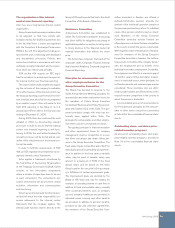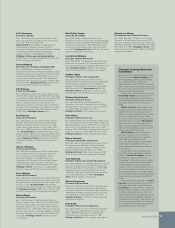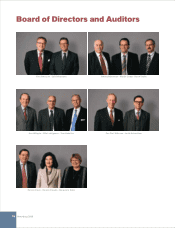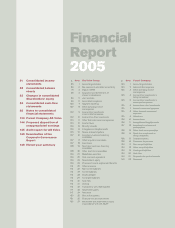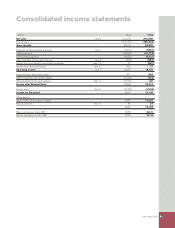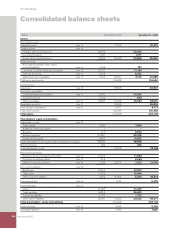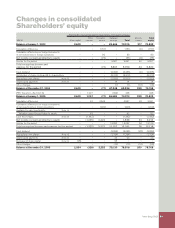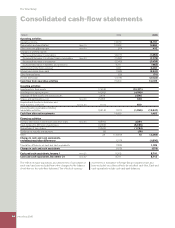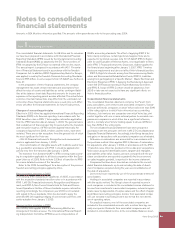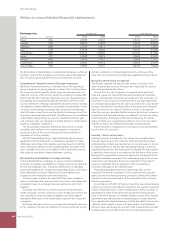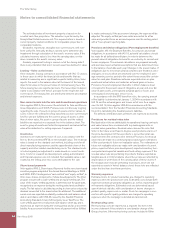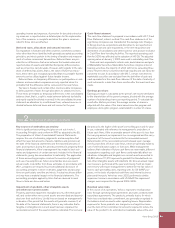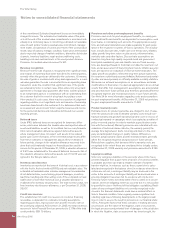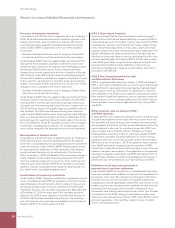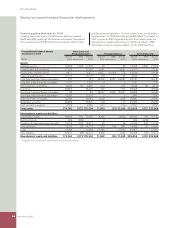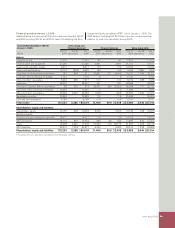Volvo 2005 Annual Report Download - page 89
Download and view the complete annual report
Please find page 89 of the 2005 Volvo annual report below. You can navigate through the pages in the report by either clicking on the pages listed below, or by using the keyword search tool below to find specific information within the annual report.
Volvo Group 2005 85
Amounts in SEK M unless otherwise specifi ed. The amounts within parentheses refer to the preceding year, 2004.
The consolidated fi nancial statements for AB Volvo and its subsidiar-
ies have been prepared in accordance with International Financial
Reporting Standards (IFRS) issued by the International Accounting
Standards Board (IASB), as adopted by the EU. Those portions of
IFRS not adopted by the EU have no material effect on this report.
This annual report is prepared in accordance with IAS 1 Presenta-
tion of Financial Statements and in accordance with the Swedish
Companies Act. In addition, RR30 Supplementary Rules for Groups,
was applied, issued by the Swedish Financial Accounting Standards
Council. IFRS differs in some respects from US GAAP, see further in
Note 37.
In the preparation of these fi nancial statements, the company
management has made certain estimates and assumptions that
affect the value of assets and liabilities as well as contingent liabil-
ities at the balance sheet date. Reported amounts for income and
expenses in the reporting period are also affected. The actual future
outcome of certain transactions may differ from the estimated out-
come when these fi nancial statements were issued. Any such differ-
ences will affect the fi nancial statements for future fi scal periods.
Changes of accounting principles
Effective in 2005 Volvo has applied International Financial Reporting
Standards (IFRS) in its fi nancial reporting. In accordance with the
IFRS transition rules in IFRS 1, Volvo applies retroactive application
from the IFRS transition date at January 1, 2004. The general rule is
that restatement of fi nancial reporting for periods after the transition
date should be made as if IFRS has been applied historically. All
comparison fi gures from 2004, in tables and the notes, have been
restated. There are certain exceptions from the general rule of which
the most signifi cant for Volvo are:
– IAS 39 Financial instruments: Recognition and measurement
which is applicable from January 1, 2005.
– Non-amortization of intangible assets with indefi nite useful lives
(e.g. goodwill) in accordance with IFRS 1 should be applied retro-
actively only from the transition date January 1, 2004.
The transition from Swedish GAAP to IFRS is being made accord-
ing to a regulation applicable to all listed companies within the Euro-
pean Union as of 2005. Refer to Note 3, Effect of transition to IFRS
for a more detailed overview of the transition.
Refer to the 2004 Annual Report for a description of the previous
Swedish accounting principles applied by Volvo.
New accounting principles in 2005
The following IFRS standards are applied as of 2005, in accordance
with the respective standards transition rules or in accordance with
IFRS 1, IAS 39: Financial Instruments: Recognition and Measure-
ment, and IFRS 5, Non-Current Assets Held for Sale and Discon-
tinued Operations. Neither of these standards requires retroactive
reporting. Accordingly, the comparison year 2004 is not restated
with regard to these standards. Volvo has decided to apply the
amended IAS 39 regarding hedging of commercial cash fl ows with
earlier adoption from January 1, 2005.
New accounting principles in 2006
As of 2006, Volvo applies IFRIC 4, Determining Whether an
Arrangement Contains a Lease. The International Financial Report-
ing Interpretation Committee (IFRIC) issue its interpretations of
IASB’s accounting standards. The effect of applying IFRIC 4 for
Volvo mainly comprises certain type-bound supplier tools and is
expected to be limited, see also note 37, US GAAP. IFRS 6, Explor-
ation for and Evaluation of Mineral Assets, is not applicable to Volvo,
while IFRS 7, Financial Instruments: Disclosure, shall be applied for
the fi nancial year beginning after January 1, 2007. IFRS 7 involves
disclosure requirements and does not affect Volvo’s fi nancial position.
IFRIC 5, Rights to interests arising from Decommissioning Resto-
ration and Environmental Rehabilitation Funds, IFRIC 6, Liabilities
arising from participating in a Specifi c Market - Waste Electrical and
Electronic Equipment, IFRIC 7, Applying the Restatement Approach
under IAS 29 Financial reporting in Hyperinfl ationary Economies
and IFRIC 8, Scope of IFRS 2, which should be adopted as from
2006 or later are not expected to have any signifi cant effects on
Volvo’s fi nancial position.
Consolidated fi nancial statements
The consolidated fi nancial statements comprise the Parent Com-
pany, subsidiaries, joint ventures and associated companies. Subsid-
iaries are defi ned as companies in which Volvo holds more than 50%
of the voting rights or in which Volvo otherwise has a controlling
infl uence. Joint ventures are companies over which Volvo has joint
control together with one or more external parties. Associated com-
panies are companies in which Volvo has a signifi cant infl uence,
which is normally when Volvo’s holding equals to at least 20% but
less than 50% of the voting rights.
The consolidated fi nancial statement have been prepared in
accordance with the principles set forth in IAS 27, Consolidated and
Separate Financial Statements. Accordingly, intra-Group transactions
and gains on transactions with associated companies are eliminated.
All business combinations are accounted for in accordance with
the purchase method. Volvo applies IFRS 3, Business Combinations
for acquisitions after January 1, 2004, in accordance with the IFRS
1 transition rules. Volvo has decided not to restate prior acquisitions.
Volvo values acquired identifi able assets, tangible and intangible,
and liabilities at fair value. Surplus amounts compared with the pur-
chase consideration are reported as goodwill. Any lesser amount,
so-called negative goodwill, is reported in the income statement.
Companies that have been divested are included in the consoli-
dated fi nancial statements up to and including the date of divest-
ment. Companies acquired during the year are consolidated as of
the date of acquisition.
Joint ventures are reported by use of the proportionate method of
consolidation.
Holdings in associated companies are reported in accordance
with the equity method. The Group’s share of reported income in
such companies is included in the consolidated income statement in
Income from investments in associated com panies, reduced in appro-
priate cases by depreciation of surplus values and the effect of apply-
ing different accounting principles. Income from associated compa-
nies are included in operating income due to that the investments
are of operating nature.
For practical reasons, most of the associated companies are
included in the consolidated accounts with a certain time lag, nor-
mally one quarter. Dividends from associated companies are not
included in consolidated income. In the consolidated balance sheet,
Notes to consolidated
fi nancial statements
Note 1 Accounting principles


